 |
 |
|||||||||||||||||||||
|
||||||||||||||||||||||
AZFO FIELD EXPEDITION
Organ Pipe Cactus National Monument
13-15 March 2015
By Eric Hough
The Sonoran Desert of southern Arizona, southeastern California, and the state of Sonora, Mexico, encompasses some of the most diverse desert ecosystems in the world. While most visitors to Arizona are familiar with the saguaros, paloverdes, mesquites, ocotillos, and cholla of the Sonoran Desert landscape, even more plant diversity lies south of the U.S.-Mexico border. Its range barely extending into the U.S. near the town of Ajo in southern Arizona (Pima County), the organ pipe cactus (Stenocereus thurberi) is one such species that is rare in our country, but becomes common as one travels southward into Sonora. Organ Pipe Cactus National Monument exists to protect the limited U.S. range of its namesake plant species, as well as other flora and fauna occupying the desert-scrub, xeroriparian canyons, and isolated springs along the international border with Mexico. In fact, this 330,688 acre park has been designated an International Biosphere Reserve by the United Nations and is part of Arizona Audubon’s Sonoran Desert Borderlands Important Bird Area (IBA). This habitat diversity attracts a large array of breeding and migratory bird species, including some that have restricted ranges within Arizona and the U.S. The official bird list of Organ Pipe Cactus N.M. lists 277 species, 63 of which have bred in the park and an additional five species that could potentially breed here (Groschupf et al. 1999).
 |
Figure 1. View of the Ajo Mountains at Organ Pipe Cactus N.M. (© Eric Hough).
|
For this expedition to Organ Pipe Cactus N.M. on 13-15 March 2015, Troy Corman and I coordinated a collaborative effort between Arizona Field Ornithologists (AZFO), the U.S. National Park Service (NPS), and Arizona Game & Fish Department (AZGFD) to conduct both nocturnal and diurnal surveys to help assess the current distribution of bird species within Organ Pipe Cactus N.M. The primary target of these surveys was the Ferruginous Pygmy-Owl, a species which has experienced steady range contraction southward within Arizona and the U.S. over the past century due to habitat loss (Monson & Phillips 1981, Corman 2005). Since the species was delisted from federally-endangered status in 2006 due to insufficient evidence of distinct subspecies level classification (the former “Cactus” Ferruginous Pygmy-Owl), surveys for the species within the park have been infrequently conducted (fide Tim Tibbitts, Troy Corman). Under approved permits obtained from NPS and AZGFD, we conducted audio playback surveys at dawn and dusk for Ferruginous Pygmy-Owls at several areas in the park.
Additionally, we gathered data on species that could help with continental and possibly global designation of the Sonoran Borderlands IBA, provided that numbers of individuals or pairs detected during IBA surveys meet certain criteria thresholds. These species included Elf Owls, Costa’s Hummingbirds, Gilded Flickers, Bell’s Vireos, and Lucy’s Warblers. All teams also collected species numbers for all resident and migratory species, along with effort data for all areas covered, to be entered into the global eBird database (ebird.org). Total species numbers can be viewed in Table 1 of the Appendix.
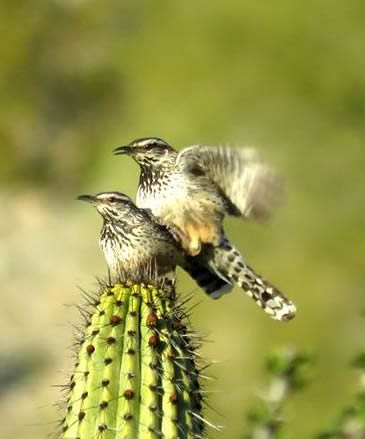 |
 |
|
| Figure 2. a) Pair of Cactus Wrens copulating (© Jarrod Swackhamer) | b) Harris’s Hawk (© Jarrod Swackhamer. |
Ferruginous Pygmy-Owl Surveys
Our 23 expedition participants split into five teams on 14 March to conduct dawn and dusk callback surveys for Ferruginous Pygmy-Owls, playing an audio file from a media player and speaker for 30 seconds, with 90-second intervals of silence in between, over a period of 10 minutes at each stop. We followed pre-existing survey transects throughout the park that NPS has used for surveying for this species previously, surveying 10 sites that day within the monument. Each stop that we conducted audio playback from was located approximately 100 meters apart. Playback of audio ceased immediately upon positive detections of the species.
While blustery conditions likely hindered detections (especially during the pre-dawn surveys), our group still managed to detect four individual Ferruginous Pygmy-Owls, including one pair. Most of our participants were fortunately able to either hear and/or see this species during these surveys, which is one of the most difficult species to find within the U.S. Some of the locations in the park where the owls were found fairly consistently in the past failed to yield any during our single surveys, while we did find these owls at one location where they had never been detected previously. With the windy conditions likely impacting detectability of the owls, it is hard to ascertain the current population levels without more follow-up surveys, which NPS plans to conduct this spring. Official surveys for this species require multiple visits during the same breeding season at each location, thus providing additional opportunity to detect owls residing there. Our few detections of this owl were not unexpected, as species at the northern extent of their range typically occur at smaller population densities and experience periodic fluctuations in numbers and breeding success. This has also been exacerbated by habitat loss outside of the park, primarily due to the loss of saguaros that they use for nesting sites and the dense xeroriparian washes that they forage in. The overall borderlands population will only stabilize if threats to their habitat are mitigated elsewhere in their Arizona and Sonora range via habitat preservation and removal of invasive grasses that increase the fire frequency and severity that kills the old-growth saguaros and xeroriparian trees that they rely upon for nesting (Corman 2005).
| Figure 3. AZFO expedition participants conducting audio callback surveys for Ferruginous Pygmy-Owls (© Anne Pellegrini). |
Breeding and Migratory Birds
Of all the breeding resident species we detected, we found breeding evidence ranging from singing territorial males, to copulating pairs, to occupied nests for many of the common species. Some species were just arriving on territory or incubating eggs in nests, so our expedition was mostly too early to detect nestlings or observe fledged young. Species that we found occupied nests of, observed carrying food, or exhibiting agitated behavior included Costa’s Hummingbird, Gila Woodpecker, Cactus Wren, Black-tailed Gnatcatcher, Curve-billed Thrasher, and Phainopepla. Of the species that Arizona Audubon is interested in documenting numbers of for the Sonoran Desert Borderlands IBA that encompasses Organ Pipe Cactus N.M. and the adjacent Cabeza Prieta National Wildlife Refuge, our surveys yielded 9 Elf Owls, 51 Costa’s Hummingbirds, 33 Gilded Flickers, one Bell’s Vireo, and 10 Lucy’s Warblers. The lower Elf Owl numbers were to be expected since the species was just starting to arrive on territory and the windy conditions impacted our owling efforts. With limited riparian areas present in the park and the species just starting to arrive, Bell’s Vireo and Lucy’s Warbler the low numbers of both were also not unusual. Gilded Flickers and Costa’s Hummingbirds are both widespread breeding species in the park and our numbers seemed typical, despite the wind impacting detections. Our expedition did not detect the locally occurring Bendire’s Thrashers and Rufous-winged Sparrows that have previously been found in the region, nor were we surveying in the right season to find Varied Buntings or the right locations in the park to find Le Conte’s Thrasher.
 |
 |
|
Figure 4. a) Phainopepla (© Eric Hough) and |
b) Canyon Towhee (© Eric Hough). |
While covering survey transects in various areas of the park in search of Ferruginous Pygmy-Owls and IBA species of interest, our participants were treated to the park’s habitat diversity. Below is a discussion of the 96 breeding and migrant bird species we detected within the major areas of the park. Total species numbers can be viewed in Table 1 of the Appendix.
AJO MOUNTAINS
 |
| Figure 5. Arch Canyon on the western slope of the Ajo Mountains (© Eric Hough). |
The teams that covered the higher elevation canyons along the Ajo Mountain Loop Drive encountered chaparral and upland Sonoran desertscrub vegetation, including Arizona rosewood (Vaquelinia californica), Mexican jumping bean (Sebastiania bilocularis), jojoba (Simmondsia chinensis), and scrub oak (Quercus turbinella). Many of these drainages, such as Alamo, Arch, Estes, Bull Pasture, and Diablo Canyons, also contained lush xeroriparian vegetation merging with the chaparral zone, including ironwood (Olneya tesota), honey mesquite (Prosopis glandulosa), paloverdes (Cercidium spp.), catclaw acacia (Acacia greggii), wolfberry (Lycium spp.), Condalia (Condalia warnockii), desert hackberry (Celtis pallida), Coursetia (Coursetia glandulosa), graythorn (Ziziphus obtusifolia), and canyon ragweed (Ambrosia ambrosioides). Surrounding these canyons and washes were saguaros (Carnegeia gigantean), cholla and prickly pear cacti (Opuntia spp.), and organ pipe cactus, the latter primarily growing on the warmer south-facing slopes.
 |
Figure 6. Chaparral and xeroriparian habitat in Arch Canyon (© Eric Hough). |
 |
| Figure 7. Sonoran Desert tortoise hatchling, with pen for scale (© Eric Hough). |
Some of the chaparral and upland desert bird species that our teams found in the Ajo Mountains included Canyon Towhee, Crissal Thrasher, Rufous-crowned and Black-chinned Sparrows. One notable find was a Costa’s Hummingbird nest in a scrub oak, a plant substrate that has not been well documented for this species, primarily due to this habitat being at the upper elevation limit for the species breeding range. Our teams also saw and heard lots of White-throated Swifts, Canyon and Rock Wrens along the high cliffs and canyon walls, and droves of Phainopeplas, Northern Mockingbirds, and Northern Cardinals in the lush xeroriparian washes. Phainopeplas were especially abundant along these washes with the preponderance of mistletoe (Phoradendron spp.) clumps that the species’ life cycle and diet is tied to. Participants had ample chances to observe Phainopepla breeding behavior and their interesting vocal repertoire, which includes mimicry of other species calls such as Vermilion Flycatcher and Bewick’s Wren.
The dense vegetation in these canyons also attracts wintering species, especially fruiting shrubs that can sustain visiting frugivorous birds. Wintering and migrant species our teams discovered in these canyons on the western slope of the Ajo Mountains included House and Bewick’s Wrens, Ruby-crowned Kinglets, Townsend’s Solitaires, Hermit Thrushes, a ‘Slate-colored’ Fox Sparrow, and ‘Oregon’ Dark-eyed Juncos.
While birds were the main focus of our expedition, every expedition allows participants to see other cool wildlife and plants. A non-avian highlight of this expedition was a tiny hatchling Sonoran Desert tortoise (Gopherus morafkai) that Jarrod Swackhamer spotted in a wash that had a carapace (shell) length of only 50mm! Our teams also found several spring wildflowers in bloom with a wide variety of butterflies visiting them, including Texas crescents (Anthanassa texana) and hackberry emperors (Asterocampa celtis).
DESERT LOWLANDS & WASHES
The lush Sonoran desert-scrub out in the flats away from the Ajo Mountains and surrounding the xeroriparian washes includes dense patches of very large saguaros, paloverdes, ironwoods, and cholla cacti, with creosote (Larrea tridentata) and ocotillo (Fouquieria splendens) in the more arid flats. Areas in the park that offer such habitat includes the park campground and visitor center, and various stretches of desert and washes along Hwy. 85 and the Puerto Blanco Loop Drive such as Kuakatch, Cherioni, and Aguajita Washes. This habitat provides breeding birds with several options for nesting sites, the saguaros being used by Gila Woodpeckers, Gilded Flickers, and secondary-cavity nesters, and cholla cacti being a favorite substrate of Cactus Wrens and Curve-billed Thrashers. Our teams found good numbers of these species, along with dozens of Gambel’s Quail, Costa’s Hummingbirds, Verdins, Black-tailed Gnatcatchers, and Black-throated Sparrows. In addition to the Ferruginous Pygmy-Owls detected during our nocturnal surveys, this verdant desert habitat was also inhabited by several Elf and Western Screech-Owls, although these species were probably undercounted because of the windy conditions we dealt with. Other desert birds of prey that our participants found included Harris’s and Red-tailed Hawks, American Kestrels, and even a pair of Zone-tailed Hawks, the latter of which is a rare and local nesting species in the park. Some participants that traveled to the park through the Tohono O’Odham Indian Reservation east of Ajo also reported seeing Crested Caracaras and Black Vultures along Hwy. 86, species which surprisingly are infrequently reported at Organ Pipe Cactus N.M. despite the similar habitat and close proximity to where these species occur on the reservation and down into Sonora.
 |
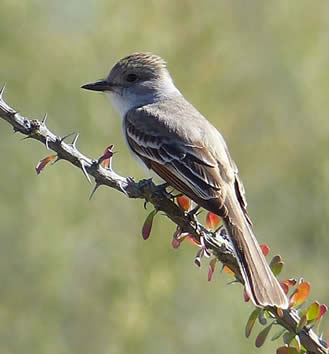 |
|
Figure 8. a) Gray Vireo at Kuakatch Wash (© Eric Hough) and b
|
b) Ash-throated Flycatcher (© David Griffin). |
The blooming mesquites and paloverdes in the desert and washes also attract migrating passerines drawn to the abundant insects pollinating these flowering trees. Migrants that our teams encountered on the expedition included Ruby-crowned Kinglets, Yellow-rumped ‘Audubon’s’, Black-throated Gray, and Wilson’s Warblers, Green-tailed Towhee, and Chipping, Brewer’s, Vesper, and White-crowned Sparrows. The Green-tailed Towhees, Brewer’s and White-crowned Sparrows are especially abundant wintering and migrant species in the weedy washes and creosote flats in this park (as well as across many areas of the Sonoran Desert), the sound of these flocks sometimes blocking out the sound of breeding residents as they all vocalize in unison. One of the main highlights of this trip was a Gray Vireo found in Kuakatch Wash by Anne Pellegrini’s team, a species which is a sparse wintering visitor in southern Arizona primarily around fruiting elephant trees (Bursera microphylla). While no elephant trees are found along this stretch of wash, the species has been found locally along desert washes with similar plant species composition in the Kofa Mountains of southwestern Arizona where it is thought to forage instead on insects and berries of other plant species (fide John Arnett and Chrissy Kondrat-Smith, unpublished data). [More information on Gray Vireos and elephant trees can be found in the December 2011 expedition description on the AZFO website here. Another highlight of this expedition was a Northern Saw-whet Owl that Troy Corman heard calling at night at the group sites at the main park campground. Winter movements of this species irregularly occur into desert lowlands of the Southwest, with a few previous records of this species in winter at Organ Pipe Cactus N.M.
QUITOBAQUITO SPRING
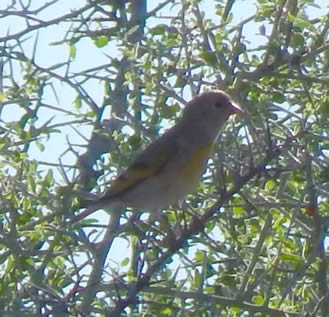 |
Figure 9. ) Lawrence’s Goldfinch (© Eric Hough). |
One of the jewels of Organ Pipe Cactus N.M. is Quitobaquito Spring, an isolated oasis right along the U.S. border with Mexico. Quitobaquito Spring has a relatively small area of riparian vegetation surrounding a small pond and trickling stream, the primary vegetation including Fremont cottonwood (Populus fremontii), honey mesquite, desert hackberry, Condalia, wolfberry, and bulrushes (Schoenoplectus sp.). From above this habitat would look very enticing to any migrant bird flying across miles of arid desert and has in the past attracted an impressive list of such rare vagrant bird species: Least Grebe, Brown Pelican, Least Bittern, Tricolored Heron, Roseate Spoonbill, Wood Stork, Black Rail, Sandhill Crane, Red Phalarope, Heermann’s Gull, Least Tern, Tropical and Thick-billed Kingbirds, Scissor-tailed Flycatcher, Red-eyed Vireo, Golden-winged, Tennessee, Magnolia, Black-throated Blue, Black-throated Green, and Blackpoll Warblers, and Scarlet Tanager (Monson & Phillips 1981, Groschupf et al. 1999). Quitobaquito Spring has undergone some artificial improvements by NPS over the years to help conserve the endemic populations of Sonoyta desert pupfish (Cyprinodon eremus) and Sonoyta mud turtles (Kinosternon sonoriense) that reside only in this spring and scattered springs and tributaries of the Rio Sonoyta watershed in nearby Sonora. Among these improvements is a shallow, concrete-bottomed canal carrying water from the spring to the pond, which likely draws in birds wanting to drink and bathe.
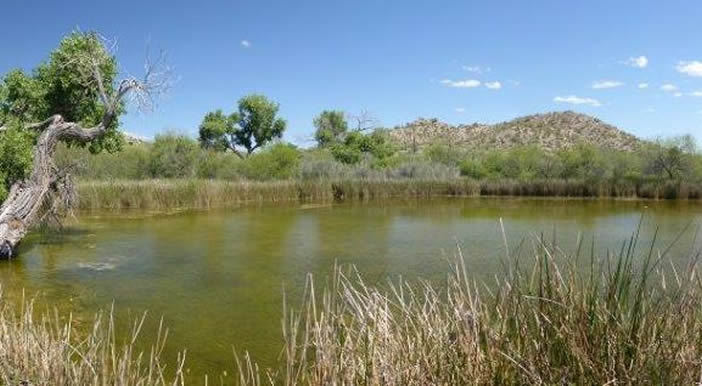 |
Figure 10. Quitobaquito Spring (© David Griffin) |
Our team that visited Quitobaquito Spring found a few breeding species that are locally found within the park, including Anna’s Hummingbird and a newly-arrived Lucy’s Warbler just starting to set up his territory. While possibly just a migrant, a lone Violet-green Swallow foraging over the pond was still of interest, since the small brachyptera subspecies that nests in large columnar cacti of coastal Sonora and Baja California has been found nesting locally at Organ Pipe Cactus N.M. and on the Barry M. Goldwater Range northwest of the park (Corman & Wise-Gervais 2005). Elsewhere in Arizona, the only Violet-green Swallows that nest in the Sonoran Desert are local colonies in riparian areas along the lower Colorado and Bill Williams Rivers, Havasupai Canyon, and near Camp Verde (Phillips et al. 1964). Interestingly, Phillips et al. (1964) suggested that the form breeding in these areas may be intermediate between brachyptera and the Arizona’s common breeding form, lepida, based on a few specimens taken along the Colorado River. The closer proximity of the Organ Pipe Cactus N.M. birds to the colonies along the Gulf of California suggests that the form here would most likely be brachyptera.
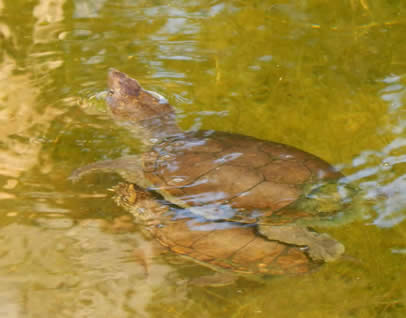 |
||
| Figure 11. a) Sonoyta mud turtles (© Eric Hough) and | b) Sonoyta desert pupfish (© David Griffin). |
Migrants this spring season were slow to trickle in across the region, with our assortment this afternoon at Quitobaquito Spring limited a Pacific-slope Flycatcher, a Marsh Wren, single Yellow-rumped and Wilson’s Warblers, a Lincoln’s Sparrow, and two ‘Mountain’ (oriantha) White-crowned Sparrows. However, our best bird here was a pair of Lawrence’s Goldfinches, a mostly California-centric species that irregularly winters and even locally breeds in western Arizona. Our only water birds that we found were a handful of American Coots swimming in and out of the bulrushes. Despite the slow bird activity in the afternoon there, it was fun to watch the pupfish and mud turtles swimming in the pond and canal, highlighted by a very tiny hatchling mud turtle tumbling down the canal current. It was also interesting being literally just a stone’s throw away from Mexico, Hwy. 2 being a mere couple hundred yards beyond the parking lot for the spring and the vehicle barriers marking this stretch of the border. Spending time here can allow the visiting birder to get a start on their Sonora and/or Mexico lists!
 |
| Figure 12. Wildlife crossing sign along Mexican Hwy. 2 as seen across the U.S.-Mexico border from Quitobaquito Spring (© Eric Hough). |
AJO WASTEWATER PONDS & GOLF COURSE
Capping off the Organ Pipe expedition, some of our participants visited the wastewater ponds and golf course in the nearby town of Ajo to further see which migrant species pass through the region. The wastewater ponds held an assortment of 10 duck species including Cinnamon Teal, Ring-necked Ducks, and Lesser Scaup, plus a few Spotted and Least Sandpipers. While we were not present in the right season more of the exciting potential coastal migrants, the proximity of this location to Puerto Peñasco (Rocky Point) on the Gulf of California would make this an ideal spot to look for wayward pelicans, boobies, herons, egrets, gulls, terns, and other coastal species blown in by late summer tropical moisture. The abundance of golfers at the Ajo Country Club limited our birding there, but the palm trees, cottonwoods, elms, mulberries, and Eucalyptus trees certainly appear to be a good draw for migrants and are ideal nesting habitat for the Great Horned Owls and Vermilion Flycatchers that we saw. The migrant potential on this day was limited to a Red-naped Sapsucker, a handful of Yellow-rumped Warblers, and a flock of 30 Chipping Sparrows, but earlier this winter a Varied Thrush had been reported on eBird at this location. Birders heading down to Organ Pipe Cactus N.M. or Rocky Point should definitely consider checking out these desert oases on their way through Ajo to see what exciting rarities might show up!
Conclusion
This expedition was one of our most ambitious yet and demonstrated the valuable partnerships that can form between volunteer groups and our state and federal agencies to help document and study avifauna through citizen science. The experience from this expedition will likely inspire future collaborations with Organ Pipe Cactus N.M. and other state and federal parks throughout the state. Despite windy conditions over this weekend, we still were able to help document the current population of Ferruginous Pygmy-Owls and other species in the park, which can potentially aid with future conservation of these rare owls and the other wildlife that inhabit these diverse Sonoran Desert habitats on both sides of the border.
 |
| Figure 13. AZFO participants surveying along Aguajita Wash (© Eric Hough). |
For our participants, this was also an opportunity to test assumptions of what the borderlands are like. This region has undergone periods of violence surrounding drug and human trafficking by Mexican cartels, yet the areas affected are constantly changing and the situation can sometimes be exaggerated by media outlets and politicians. Currently, Organ Pipe Cactus N.M. is safer than it has been in recent years, exemplified by the recent reopening of the Puerto Blanco Drive/Quitobaquito Spring area to the public after years of closure following increased cartel violence in the early 2000’s. While some of our teams did see signs of continued drug smuggling and illegal immigration in the form of discarded clothing and garbage, we also noted decreased levels of Border Patrol presence than is often found in other areas of southern Arizona that are currently dealing with increased illegal activity along the border. Hopefully Organ Pipe Cactus N.M. will continue to see decreased border strife into the future so that both the wildlife and human visitors can enjoy this park safely. This park is one of the crown jewels of the Southwest and is a place that everyone should place on their bucket-list. While traveling in groups and being aware of your surroundings is always recommended when traveling near the border, potential visitors should not be discouraged from checking out the amazing biological diversity that this park contains.
Additionally, Organ Pipe Cactus N.M. allows visitors a glimpse of the habitat diversity that occurs right across the border in Mexico. Many areas in Mexico are very under-birded, especially in the state of Sonora. The diverse Sonoran Desert vegetation seen at this park is only a taste of the incredible plant and wildlife diversity that lies only a half-day to a day’s drive south of the border in the rocky coastline, mangroves, Madrean pine-oak forest, tropical deciduous forest and thorn-scrub habitat of Sonora. Hopefully visiting this park will inspire birders to broaden their horizons and travel outside their comfort zones to experience the incredible biodiversity that occurs on both sides of the border!
Troy and I would like to thank the NPS and AZGFD for permitting and coordinating these surveys, and the following participants who contributed to this expedition’s success: Andrew Antaya, Nathan Banfield, Tyler Coleman, Sarah Dubose, Sally Flatland, Steve Ganley, John Grahame, David Griffin, Jim and Gloria Lawrence, Sue Kozacek, Deanna MacPhail, Larry Norris, Deirdre O’Connell, Anne Pellegrini, Kurt Radamaker, Terry Rosenmeier, Jean Siesener, Jarrod Swackhamer, Matt and Karen Vandzura, and Joe Veverka. We especially thank the staff at Organ Pipe Cactus N.M. for graciously waving fees for our participants, providing us with a group camping site, and granting us access to help conduct these surveys.
We hope that reading this will encourage you to join us on our upcoming AZFO expeditions!
 |
LITERATURE CITED
Corman, T.E. 2005. Ferruginous Pygmy-Owl (Glaucidium brasilianum) In Arizona Breeding Bird Atlas (T.E. Corman and Cathy Wise-Gervais, Eds). University of New Mexico Press: 218-219.
Groschupf, K., Brown, B.T., and R.R. Johnson. 1999. A Checklist of the Birds of Organ Pipe Cactus National Monument. Cooperative National Park Resources Study Unit, University of Arizona, Tucson. Southwest Parks and Monument Association. 10 p.
Monson, G., and A.R. Phillips. 1981. Annotated Checklist of the Birds of Arizona, 2nd edition. University of Arizona Press. 240 p.
Phillips, A. R., Marshall, J., and G. Monson. 1964. The Birds of Arizona. University of Arizona Press, Tucson. 212 p.
APPENDIX
Table 1. Numbers of bird species recorded at Organ Pipe Cactus N.M. and at the wastewater ponds and golf course at the nearby town of Ajo.
 |
|
©2010 |
HOME | | | REPORT SIGHTINGS | | | PHOTOS | | | BIRDING | | | JOURNAL | | | ABOUT US | | | CHECKLISTS | | | AZ BIRD COMMITTEE | | | EVENTS | | | LINKS |